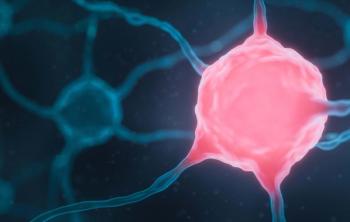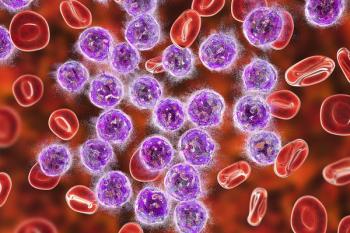
Commentary on Abstracts #613, #1645, #1035, and #1384
Thalidomide (Thalomid) has been commercially available in the United States since October 1998. The use of thalidomide in the treatment of malignancies is growing as its potential utility for treating multiple myeloma, renal-cell cancer, and AIDS-
Thalidomide (Thalomid) has been commercially available in the United States since October 1998. The use of thalidomide in the treatment of malignancies is growing as its potential utility for treating multiple myeloma, renal-cell cancer, and AIDS-related Kaposi’s sarcoma is becoming more widely appreciated.
Glioblastoma Multiforme
Marx et al (abstract #613) reported a phase II study using thalidomide as an antiangiogenic agent in the treatment of recurrent glioblastoma multiforme. Thirty-seven patients received escalating doses of thalidomide from 100 mg/d to a maximum of 500 mg/d. Thirty-four patients were assessable for response: 5 (15%) patients achieved a partial response (PR) and 11 (32%) achieved stable disease (SD), with an overall response rate of 47%. These results suggest that in glioblastoma multiforme, thalidomide has antitumor activity at least equivalent to the standard therapy (either temozolomide or procarbazine [Matulane]).
As shown in a phase III trial (Proc Am Soc Clin Oncol 18:139a[abstract #532], 1999) of temozolomide vs procarbazine in glioblastoma multiforme at first relapse, 112 patients who received temozolomide had an overall response rate of 45.6% (PR 5.4%, SD 40.2%), compared with 32.7% (PR 5.3%, SD 27.4%) for 113 patients who received procarbazine. In addition, the 6-month overall survival rate for temozolomide was 60% vs 44% for procarbazine, with a P value of .019. Determining whether thalidomide is a more effective therapy for patients with recurrent glioblastoma multiforme will require a randomized trial with both response rate and overall survival as end points.
Carcinoma of the Head and Neck
Tseng et al (abstract #1645) reported a phase II trial of thalidomide in the treatment of recurrent and/or metastatic squamous cell carcinoma of the head and neck. The thalidomide dose was escalated from 200 to 1,000 mg/d. The median duration of treatment was very short at only 1.25 months. Of the 17 patients treated, 16 had progression of disease, and 1 was inevaluable due to early death. The median survival for the 17 patients is only 5.4 months, which is similar to that of historical controls. It was noteworthy that the incidence of fatigue (94%), nausea/vomiting (41%), and edema (53%) appears to be significantly higher than those reported in the other studies. These data suggest that thalidomide is inactive as a single antitumor agent in recurrent and/or metastatic squamous cell carcinoma of the head and neck.
Hepatocellular Carcinoma
Prompted by the observation of a disease response in a patient with refractory hepatocellular carcinoma treated with thalidomide, Patt et al (abstract #1035) conducted a phase II trial of thalidomide for nonresectable hepatocellular carcinoma. The dose of thalidomide was escalated from 400 to 1,000 mg/d in 5 weeks. Twenty-one patients were evaluable for disease response: 1 patient had a partial response (5%), 1 had minor response (5%), and 10 had stable disease (48%) for at least 2 months. The authors conclude that thalidomide may offer disease stabilization in patients with hepatocellular carcinoma but did not have significant antitumor activity. Nevertheless, thalidomide should be considered active in this patient population because more than 50% of the treated patients remained progression-free for at least 2 months. As suggested by the authors, the combination of thalidomide and another chemotherapy agent, such as capecitabine (Xeloda), may be more effective treatment for this chemotherapy-resistant malignancy.
Renal-Cell Carcinoma
Minor and Elias (abstract #1384) reported their preliminary experience in patients with metastatic renal-cell carcinoma. Thalidomide was administered as a divided daily dose escalating from 400 to 1,200 mg/d. Among 12 treated patients, 1 achieved a partial response, 1 minor response, and 3 stable disease. Both responders had failed high-dose interleukin-2 therapy. These results suggest that thalidomide has antitumor activity in patients with renal-cell carcinoma. Younger, good performance status patients tolerated higher dosages, in agreement with pharmacokinetic data that suggest an inverse relationship between thalidomide clearance and age. Based on this report, thalidomide should be explored in combination with other classically active agents, such as biologic therapy.
Newsletter
Stay up to date on recent advances in the multidisciplinary approach to cancer.





















































































